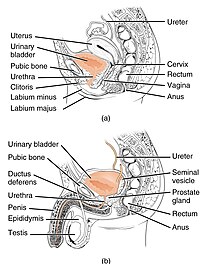
Photo from wikipedia
Background Back problems and urinary incontinence (UI) have been found to co-occur more frequently than would be predicted by chance. Objective The aim of this study was to estimate the… Click to show full abstract
Background Back problems and urinary incontinence (UI) have been found to co-occur more frequently than would be predicted by chance. Objective The aim of this study was to estimate the associations between UI and back problems in the Canadian men and women. Design This was an observational, cross-sectional study. Methods The 2011-2012 Statistics Canada Canadian Community Health Survey (CCHS) provided the data. The CCHS surveyed 125,645 adults, providing a representative sample of the Canadian population. Odds ratios (ORs) and 95% confidence intervals (CIs) were used to quantify the strength of the associations among the variables. Results Having UI increased the risk of also having back problems in both men (OR = 2.45; 95% CI = 2.06-2.91) and women (OR = 2.97; 95% CI = 2.64-3.35) compared with not experiencing UI. Among those participants with UI, men and women were at equal risk of experiencing back problems. Limitations The CCHS data are cross-sectional and self-reported, which prevents determining causality and carries a risk of response bias. Also, various diagnoses were grouped under the back problems and UI categories, which makes it difficult to propose possible explanations for this pattern of comorbidity. Conclusions This study provides firm evidence to support clinically observed associations between UI and back problems. The strength of the associations was essentially equal in men and women. These findings reinforce the importance of screening for these frequently coincident conditions.
Journal Title: Physical Therapy
Year Published: 2017
Link to full text (if available)
Share on Social Media: Sign Up to like & get
recommendations!